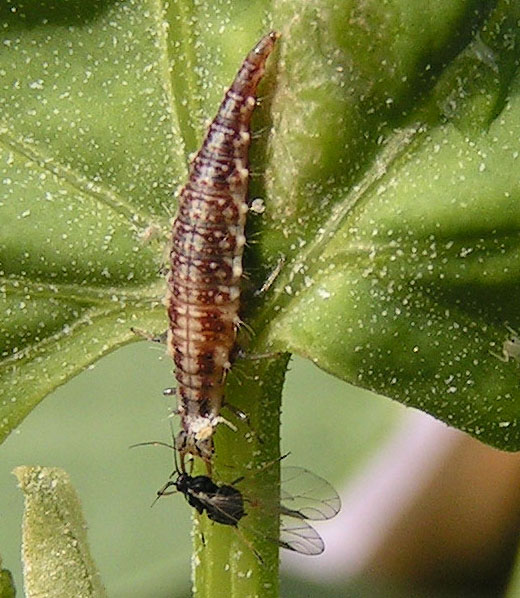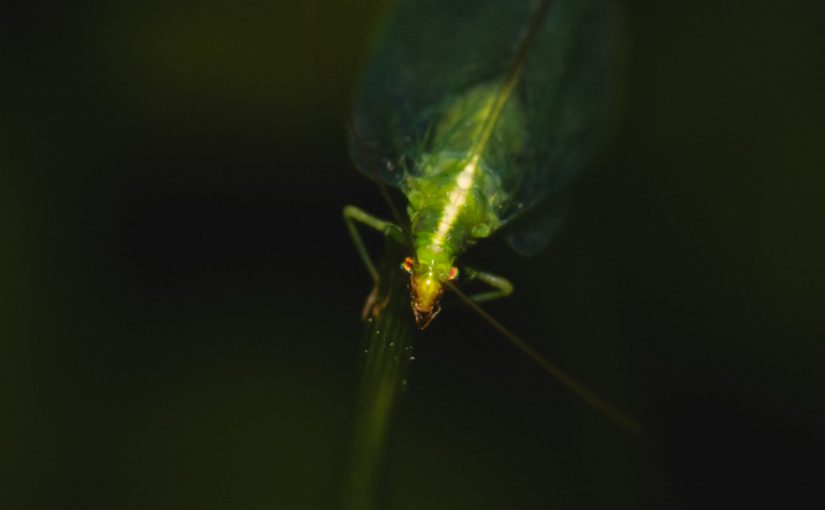Green lacewings are a sought after beneficial insect. They are capable predators in their larval stages, with distinct appearance throughout their life cycle. This post will cover some statistics and information about them, Chryspoperla carnea specifically.

Life Cycle: Lacewings undergo complete metamorphosis. They start as eggs, usually pale green to yellow in appearance, and are attached to long stalks. Their larval state has three instars, and this is when it is effective as a predator. Adults typically feed on pollen and nectar. Larvae are flat, grayish brown, andare often compared to alligators. They will feed on most anything, and do so voraciously, which is why they are so useful. A larva can consume as many as 250 leafhopper nymphs, 400 aphids, 11,200 spider mites, or 3,780 scale insects. When the larva is ready, it weaves a silk cocoon, white in appearance, and pupates for up to two weeks. They then emerge as adults, who are light green and .5-.75 inches long, with elaborately veined wings.
This process usually takes one to two months. The egg takes from a few days to two weeks, the larva 14-28 days, and the mature adults live for 20-40 days.

Habitat: A lacewing larva’s effectiveness often has to do with its host plant, and hairy or waxy leaves may make it more difficult to reach pests. They typically prefer temperatures between 60-90 degrees, with a 30% or higher humidity. Larva will eat more the faster their metabolism goes, so they are often more effective in warmer climates.
It is important to consider overwintering sites when you are trying to establish lacewings on your farm. They overwinter in low vegetation, and cover crops can be a great place for them to do this. Hedgerows are also an important aspect, as adults generally feed on flower nectar. It is generally good to have flowering plants and hedgerows to maximize the amount of predatory insects that stop by them. Some of their favorite flowers include safflower, alfalfa, borage, and lupine.
Distribution: C. carnea has a Holarctic distribution, and can be found across North America, Europe, North Africa, and Asia. This wide distribution has caused researchers to split this species into several cryptic sister species, which can be identified by reproductive isolation and unique courtship songs. It is very difficult to distinguish between these species, and impossible without live specimens.
Release: It is best to release larvae before pest populations are hugely out of control. It can be difficult for them to establish without anything to eat, however if pests are thriving too much the lacewings may not be able to control them alone. It is an important balance, and providing good areas for other beneficials to thrive is also important.
There are different methods of egg release, and they can be released at different maturities. Parasitoids will sometimes attack eggs, and if this becomes a problem it may be best to release mature eggs or larvae that have already hatched.
Biological Control: How useful are lacewings?
Many of the articles I’ve been reading note the importance of tritrophic (plant – herbivore – predator) relationships in lacewing life cycles. Plants with excessive hairs or trichomes will be more difficult for larvae to traverse, and if they fall off their host plant they are significantly more vulnerable to other predators. Younger larvae do get eaten by other higher predators, which can be affected by when larvae are released, and how many other generalist predators appear in your farm or garden. Lacewing larvae are voracious, and if the plant is suitable for them they can consume a considerable number of pests.
With that said, they will not do well in all situations. Spider mites are often hard to reach once they’ve established webs, and eggs and larvae can become dinner to many other predators if situations arise.
Regardless of this, lacewings are sought after for a reason, and it is not unwise to try and establish populations of your own. Hedgerows and flora can help attract adults, which will help the population continue to cycle.

How do you get the ‘continue reading’ link at the bottom of your posts? Awesome photos!
When you’re typing a post, hit the ‘text’ tab next to visual, then hit the ‘more’ button. Then probably turn it back to visual so it doesn’t look terrible